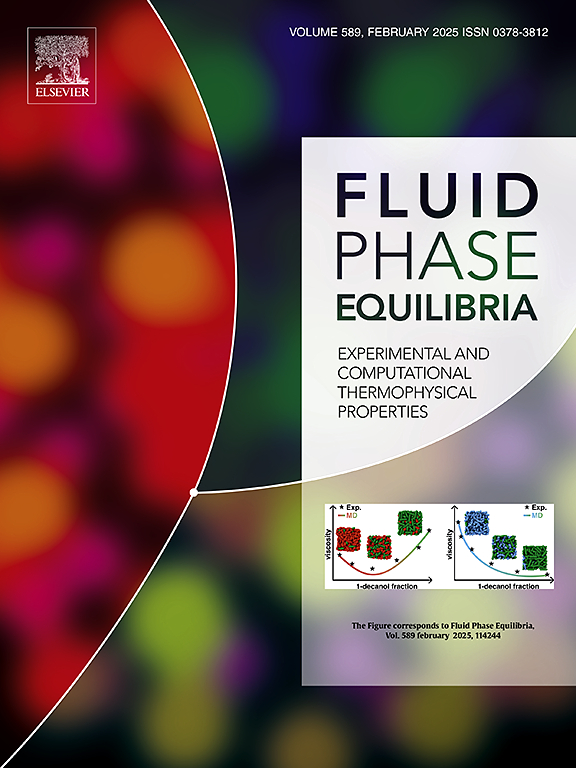Ternary Liquid – Liquid and Binary Liquid – Liquid, Solid – Liquid, and Vapour – Liquid equilibria of systems containing ε-Caprolactam, Water, n-Hexadecane, and o-Xylene
IF 2.7
3区 工程技术
Q3 CHEMISTRY, PHYSICAL
引用次数: 0
Abstract
This study reports equilibrium experimental data of binary and ternary systems containing ε-caprolactam. Solid – liquid equilibria (SLE), and isobaric bubble points were measured for the binary system ε-caprolactam + o-xylene. SLE and liquid – liquid equilibria (LLE) were measured for the binary system ε-caprolactam + n-hexadecane. Ternary LLE were measured for the systems ε-caprolactam + water + n-hexadecane or o-xylene at temperatures 298 – 323 K and atmospheric pressure. The isobaric bubble point and the ternary systems’ phase boundaries were predicted prior to the experiments with the universal quasi-chemical functional group activity coefficients – Dortmund modified (UNIFAC–Dortmund) model to ascertain the experimental conditions. Binary interaction parameters for the nonrandom, two-liquid (NRTL) model were regressed based on the measured systems of this work and additional data from the literature sources. Good agreement was found between the experimental data and the NTRL model. The results from this study provide insights into the phase behaviour of mixtures containing ε-caprolactam, facilitating process design in relevant industrial processes.
含ε-己内酰胺、水、正十六烷和邻二甲苯体系的三元液-液、二元液-液、固-液和汽-液平衡
本文报道了含ε-己内酰胺的二元和三元体系的平衡实验数据。测定了ε-己内酰胺+邻二甲苯二元体系的固液平衡(SLE)和等压泡点。测定了ε-己内酰胺+正十六烷二元体系的SLE和液液平衡(LLE)。测定了ε-己内酰胺+水+正十六烷或邻二甲苯体系在298 ~ 323 K和常压下的三元LLE。采用通用准化学官能团活度系数多特蒙德修正(unifacd - Dortmund)模型预测了等压泡点和三元体系的相界,确定了实验条件。基于实测系统和文献资料,对非随机双液(NRTL)模型的二元相互作用参数进行了回归。实验数据与NTRL模型吻合较好。本研究的结果为ε-己内酰胺混合物的相行为提供了新的见解,为相关工业过程的工艺设计提供了便利。
本文章由计算机程序翻译,如有差异,请以英文原文为准。
求助全文
约1分钟内获得全文
求助全文
来源期刊

Fluid Phase Equilibria
工程技术-工程:化工
CiteScore
5.30
自引率
15.40%
发文量
223
审稿时长
53 days
期刊介绍:
Fluid Phase Equilibria publishes high-quality papers dealing with experimental, theoretical, and applied research related to equilibrium and transport properties of fluids, solids, and interfaces. Subjects of interest include physical/phase and chemical equilibria; equilibrium and nonequilibrium thermophysical properties; fundamental thermodynamic relations; and stability. The systems central to the journal include pure substances and mixtures of organic and inorganic materials, including polymers, biochemicals, and surfactants with sufficient characterization of composition and purity for the results to be reproduced. Alloys are of interest only when thermodynamic studies are included, purely material studies will not be considered. In all cases, authors are expected to provide physical or chemical interpretations of the results.
Experimental research can include measurements under all conditions of temperature, pressure, and composition, including critical and supercritical. Measurements are to be associated with systems and conditions of fundamental or applied interest, and may not be only a collection of routine data, such as physical property or solubility measurements at limited pressures and temperatures close to ambient, or surfactant studies focussed strictly on micellisation or micelle structure. Papers reporting common data must be accompanied by new physical insights and/or contemporary or new theory or techniques.
 求助内容:
求助内容: 应助结果提醒方式:
应助结果提醒方式:


